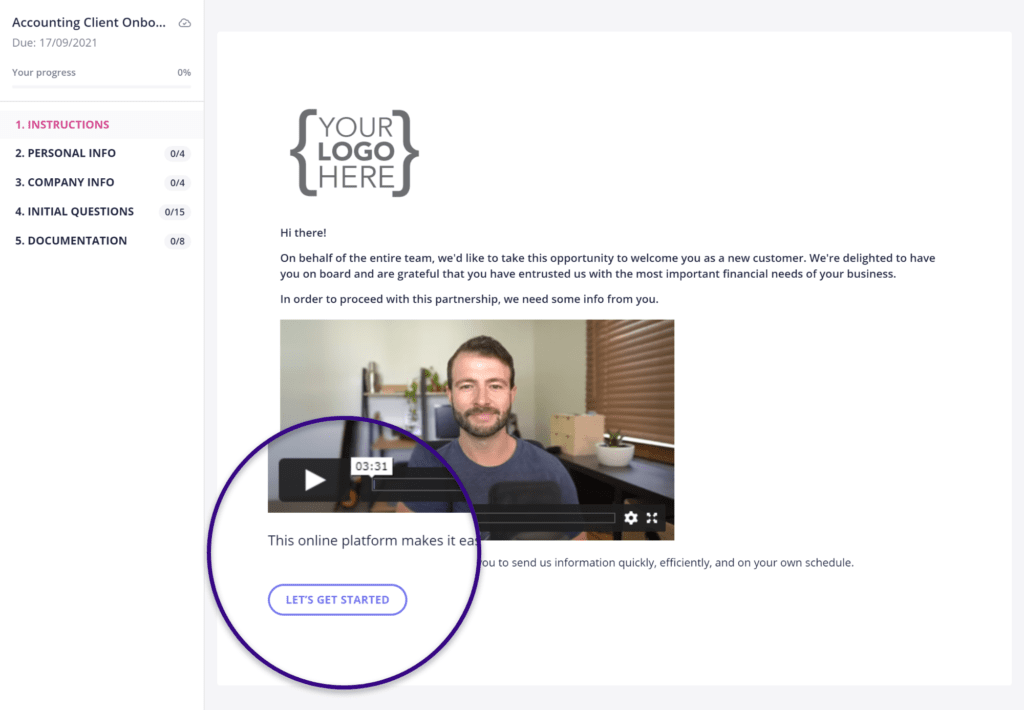In today’s highly complex world, businesses must work with multiple vendors to procure the goods, services, and technology they need to run smoothly. But to ensure a fruitful relationship with new vendors, you need to deliver a comprehensive vendor onboarding process.
In this article, we’ll explain everything you need to know about the vendor onboarding process, covering:
- Key objectives of vendor onboarding
- The components of a successful vendor onboarding process
- Vendor onboarding best practices
But before we dive in, let’s define what we’re talking about.
What is vendor onboarding?

Sometimes known as supplier onboarding, vendor onboarding is the process of welcoming and integrating new vendors into your organisation’s operations. In this context, a vendor is an entity that provides goods or services to another business or organisation.
The vendor onboarding process lays the foundations for a collaborative and mutually beneficial working relationship, enabling the vendor to best serve you and meet your needs. Here are some of the key objectives of the vendor onboarding process:
- Seamless integration with your existing business ecosystem
- Relationship building between the vendor and your business
- Alignment on key performance metrics, expectations, and quality standards
- Setting up clear communication channels and aligning workflows
- Identifying any potential risks or compliance issues at an early stage
When these objectives are realised, the vendor onboarding process can yield all sorts of benefits for your business, allowing you to boost operational efficiency, reduce costs, and scale faster.
The components of a successful vendor onboarding process

So what exactly does a successful supplier onboarding process look like? In this section, we’ll look at the steps involved.
Note: The exact step you’ll need to take will depend on various factors, including the industry you operate in, your organisational requirements, and the complexity of the vendor’s offering.
The example below is for a technology or software vendor. If you are onboarding a vendor that offers non-tech-related services, for example, you’ll have to ignore certain parts of this process and perhaps modify others. But generally speaking, most of the steps below can be applied to vendors of any kind.
The pre-onboarding stage
Before you start the actual onboarding stage, there are several key steps you need to follow to set yourself up for success and ensure that you’ve chosen to work with the right vendor. Here are some examples.
1. Identify vendor requirements
This initial stage is all about identifying your business’s requirements for a vendor partnership. This might involve asking questions such as:
- Does the vendor offer the goods and services we need?
- Does the vendor meet our quality standards or expectations for these goods or services?
- Are the vendor’s goods or services available within our budget?
- Is the vendor able to supply us with their goods and services in the required amount or frequency?
- Is the vendor able to meet our desired timeline for implementation or delivery?
- Is the vendor able to meet our specific compliance requirements?
- Does the vendor offer the level of customer support or pre-sales support that we expect?
Answering these questions will help you narrow down the field and choose a vendor that aligns with your business’s needs, values, and strategic objectives.
2. Establish clear expectations and performance metrics
It’s important that you establish clear expectations around the vendor’s performance from the start. This will help avoid disappointment or even conflict further down the line. This involves defining the KPIs you will use to assess the vendor’s performance, including:
- Delivery time
- Product quality
- Customer service
- Compliance or contractual obligations
By setting clear, measurable benchmarks, you establish a relationship based on mutual understanding and transparency. You also provide a logical basis for evaluating vendor effectiveness throughout the relationship.
3. Conduct due diligence and vendor risk assessments
Before you decide to work with a vendor, you need to conduct a thorough due diligence. This is part of the vendor approval process and will help you assess any risks associated with entering into a relationship with them. Typically this process involves evaluating the vendor’s:
- Financial situation and stability
- Reputation — including any reviews and references
- Industry experience
- Compliance with legal and regulatory requirements
This will help you identify any risks, vulnerabilities, or concerns, allowing you to make an informed decision about whether to work with a vendor or not.
The onboarding stage

Once you’ve decided to work with a vendor, it’s time to start the onboarding process. Here are some important steps to consider.
1. Create an onboarding roadmap and timeline
Establishing an onboarding roadmap helps ensure that the process follows a logical set of steps, and that each part of the process happens at the right time. Once you’ve created an onboarding roadmap, you can save it as a template to guide future onboarding processes.
Here are some steps to consider:
- Identify key milestones for a successful onboarding
- Determine a sequence of tasks and dependencies
- Assign tasks and resources to the right people — and set realistic deadlines
- Document the roadmap and share it with relevant stakeholders
2. Establish communication channels and points of contact
Clear communication is critical throughout the onboarding process and beyond. You’ll need to determine primary points of contact for both your business and the vendor, as well as the channels you’ll use to communicate — e.g. email, phone, or communications tools like Slack.
Make sure you also agree on the frequency of communication. Urgent issues aside, how often will you check in with the vendor to discuss progress and ensure that your KPIs are being met?
3. Gather key vendor information and documents
You’ll need to gather key information from the vendor to integrate them with your current systems. This might include:
- Contact details
- Basic info about the business (name, address of HQ, etc.)
- Legal and compliance documentation
- Any relevant certifications or accreditations (e.g. SOC 2, relevant ISO standards)
- Bank account details
- Product or service catalogues
- Contracts and agreements
With a dedicated data-collection tool like Content Snare, you can streamline the registration and data-collection process. Content Snare allows you to build custom forms that guide vendors through the submission process step by step.
4. Share relevant information with the vendor
Vendor onboarding requires an exchange of information. You’ll need to make sure they have all the relevant documentation, protocols, and guidelines they need to work with you harmoniously.
Depending on the type of product or service they offer, the vendor may also need to know about your reporting structures, escalation procedures, and security-related protocols.
5. Conduct system integration and data exchange
If you are procuring IT, tech, or SaaS products from your vendor, you’ll need to coordinate with their IT team to integrate their product or service with your systems.
This stage will involve things like defining data exchange protocols, testing data transfer and integration, and addressing any technical issues or challenges that arise.
6. Test and validate vendor deliverables
Finally, it’s important that you conduct thorough testing of the vendor’s deliverables, verifying that the product or service you have procured meets the agreed-upon specifications. This will include assessing quality, performance, functionality, and any other relevant criteria.
It may also be worth seeking feedback from various internal stakeholders who have used the product or service. If any issues or discrepancies arise, you can work with the vendor to resolve them at this early stage.
The post-onboarding stage
Once you are up and running with your new product or service, it’s important to continue working closely with the vendor to ensure that the relationship is yielding the results you expect. Here are some ways you can do that.
- Conduct regular performance evaluations against your pre-defined KPIs
- Identify areas for continuous improvement, optimisation, and updates
- Raise any concerns or issues as they arise
- Review and update contracts and agreements as necessary
Best practices for the supplier onboarding process

Now we know the steps that make for an effective vendor onboarding process should include, let’s look at some vendor onboarding best practices to maximise your chances of success.
1. Standardise the process
Given that you’ll inevitably have to onboard multiple vendors over time, it makes sense to standardise the process as much as possible. This ensures that future processes are more efficient and consistent. Here are some ways you can do this:
- Create a vendor onboarding checklist for internal use
- Develop vendor onboarding form templates
- Build a central repository for easy access to all vendor-related information and documentation
2. Be flexible and adaptable
You can standardise the process as much as possible, but it’s still important to remember that every vendor is different. Chances are, you’ll never find a vendor that perfectly meets every criteria you have, so a degree of flexibility is always important.
In some cases, you may need to adapt your onboarding process to suit a particular vendor. Onboarding a vendor that provides physical security services will require a slightly different process than onboarding a vendor that provides SaaS products, for example.
In other cases, vendor feedback may help you to fine-tune or overhaul certain parts of your process.

3. Foster clear communication
We’ve touched on this in the previous section, but it’s worth mentioning again. Fostering clear and transparent communication is the key to successful supplier relationships — from onboarding to beyond.
In practice, this means establishing clear lines of communication and points of contact, engaging in regular communication, and being open and honest about expectations, goals, and concerns.
4. Leverage technology
It goes without saying, but the right technology is key to developing seamless onboarding processes, allowing you to improve the efficiency, accuracy, and effectiveness of your vendor onboarding process. Here are some examples of tools you can use:
- Vendor management and e-procurement software: Using a vendor management system like Kissflow Procurement Cloud, SAP Ariba, or Coupa can help you streamline the processes involved in sourcing, onboarding, managing, and paying vendors.
- Electronic data interchange software: EDI systems automate the exchange of documents between your business and the vendor, allowing you to streamline order placement and invoicing.
- Contract management software: Tools like DocuSign and PandaDoc allow you to automate and digitise contract generation, management, and signing.
- Form building software: Tools like Content Snare streamline the process of requesting and gathering vendor data, information, and documentation.
- Document management software: Tools like Google Drive and Dropbox enable you to securely manage and store vendor-related documents.
- Task management software: Tools like Asana and Basecamp make it easy to organise, assign, and manage the tasks that comprise vendor onboarding.
- Workflow automation tools: With tools like Zapier and Make, you can connect different apps to automate basic tasks, saving you countless hours in the process.
It’s worth noting that every business is different, and the exact tools that are right for you will depend on your budget, company size, existing systems, and appetite for things like automation.
Whatever you choose, be sure to thoroughly evaluate the features, compatibility, support, and UX of a tool before making a decision.

